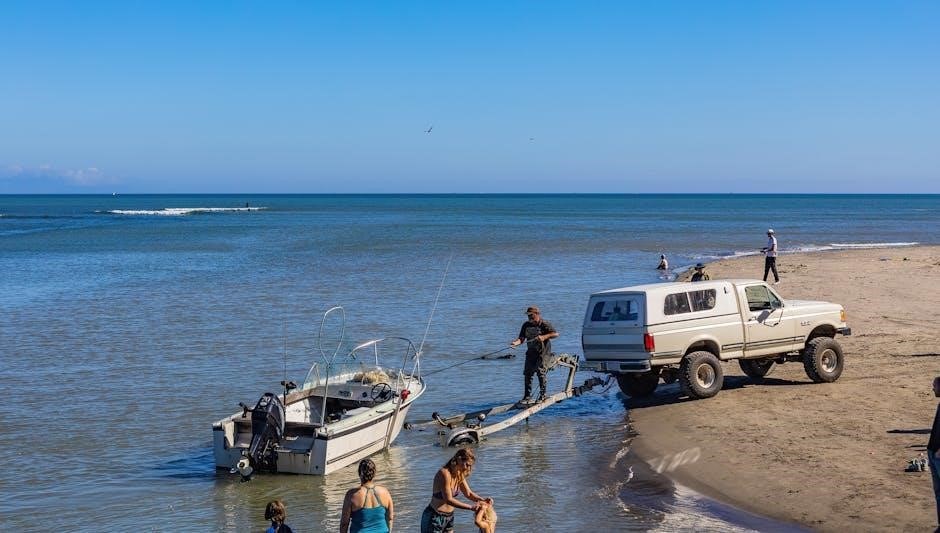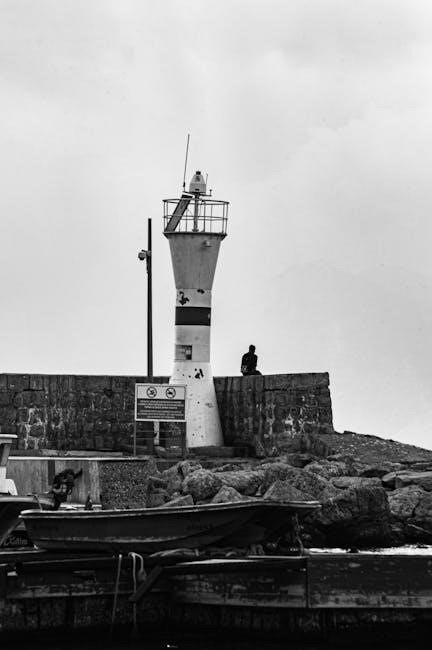
trailer guides for boat
Boat trailer guides are essential accessories designed to simplify the process of loading and unloading boats onto trailers, ensuring safe and accurate alignment every time.
1.1 What Are Boat Trailer Guides?
Boat trailer guides are structures attached to trailers to assist in aligning boats during loading and unloading. They come in styles like bunk, post, and roller, providing support and visibility. Typically made from durable materials like rustproof electro-galvanized steel, they feature adjustable height and width for compatibility with various boat sizes. These guides ensure safe and efficient maneuvering, reducing the risk of damage to both the boat and trailer.
1.2 Importance of Trailer Guides
Boat trailer guides are crucial for safe and efficient boat loading and unloading. They provide clear alignment, reducing damage risks to both boat and trailer. Their visibility, especially when submerged, ensures accurate maneuvering. Trailer guides also enhance stability, minimizing wobbling during transport. Compatible with various boat sizes and trailer types, they offer versatility. By simplifying the process, they make boating more enjoyable and stress-free.

Types of Boat Trailer Guides
Boat trailer guides come in three main types—bunk-style, post-style, and roller-style—each designed to assist in aligning and securing boats during loading and unloading.
2.1 Bunk-Style Trailer Guides
Bunk-style trailer guides feature padded, carpeted surfaces that cradle the boat’s hull, providing excellent support and protection during loading and unloading. They are typically 18 to 24 inches tall, making them ideal for smaller boats like ski boats and fishing boats. These guides are easy to install and offer a gentle, non-abrasive surface to prevent damage to the boat’s finish.
2.2 Post-Style Trailer Guides
Post-style trailer guides are tall, upright poles with visible markers, typically ranging from 40 to 60 inches in height. They are ideal for larger boats and provide excellent visibility when the trailer is submerged. These guides are durable, often made of rust-resistant materials like electro-galvanized steel, and are adjustable to fit various boat and trailer configurations, ensuring safe and precise alignment during loading and unloading.
2.3 Roller-Style Trailer Guides
Roller-style trailer guides feature rollers that cradle the boat’s hull, offering a smooth and gentle loading experience. They are ideal for boats with curved or delicate hulls, reducing friction and preventing damage. These guides are adjustable, durable, and often combined with post-style markers for enhanced visibility. Roller guides are particularly popular among anglers and sailors, providing a low-maintenance solution for easy boat maneuvering during launch and retrieval.
Features of Boat Trailer Guides
Boat trailer guides offer durable materials, high visibility, and easy adjustability, ensuring safe and efficient boat loading. They enhance trailer functionality and protect your vessel during transport.
3.1 Height and Visibility
Proper height and visibility are critical for effective trailer guides. Bunk-style guides are typically 18-24 inches tall, while post-style guides range from 40-60 inches, ensuring visibility even when submerged. Bright colors or reflective materials enhance visibility, aiding in safe loading and unloading. Adjustable heights allow customization to fit various trailer frames and boat sizes, ensuring alignment accuracy and ease of use in different conditions.
3.2 Material and Construction
Boat trailer guides are crafted from durable materials to withstand harsh marine environments. Electro-galvanized steel and aluminum are popular choices for their rust resistance, especially in saltwater conditions. PVC pipes or padded bunks provide cushioning, protecting the boat’s hull during loading. Heavy-duty construction ensures longevity, while adjustable and corrosion-resistant hardware offers reliable performance. Materials are chosen for strength, durability, and resistance to environmental factors, ensuring safe and secure boat transportation.
3.3 Adjustability and Customization
Boat trailer guides often feature adjustable height and width settings, allowing owners to customize the setup for their specific boat and trailer. This adjustability ensures proper alignment and ease of use. Some models include predrilled holes for compatibility with various trailer frames, while others offer interchangeable parts for tailored fitment. Customization options enhance functionality, making it easier to load and unload boats of different sizes and types safely and efficiently every time.
How to Choose the Right Trailer Guides
Selecting the right trailer guides involves considering boat size, trailer frame compatibility, and personal preference for height and visibility. Proper fit ensures safe and efficient loading.
4.1 Considerations Based on Boat Size and Type
When selecting trailer guides, it’s crucial to match them to your boat’s size and type. Smaller boats, like ski boats, may require shorter, more compact guides, while larger vessels need taller, sturdier options. Consider the boat’s hull design and weight to ensure proper support. For example, sailboats may benefit from adjustable post-style guides, while fishing boats might prefer roller-style for smoother loading. Always choose guides that align with your boat’s specific needs for safe and efficient use.
4.2 Trailer Frame Compatibility
Trailer frame compatibility is essential for proper installation and functionality. Guides must fit your trailer’s frame size, whether it’s 1.5×4, 2×4, 2×3, or 3×3 inches. Ensure the guides are compatible with your trailer’s material, such as galvanized or aluminum. U-bolt attachments are common for secure mounting. Some guides, like Lund-specific models, are predrilled for a perfect fit, eliminating the need for drilling. Always verify compatibility to ensure a safe and secure setup for your boat.

Installation and Setup
Installing boat trailer guides requires basic tools and a step-by-step approach. Ensure proper alignment and secure mounting for safe and efficient boat loading and unloading.
5.1 Tools and Materials Needed
To install boat trailer guides, you’ll need a wrench or socket set, a drill (if drilling is required), U-bolts or mounting hardware, and a tape measure. Ensure the guides are rustproof and include PVC pipes or carpeted bunks for protection. Some kits, like the Lund Bullseye, come predrilled, eliminating the need for additional tools. Always check compatibility with your trailer frame size (e.g., 1.5×4, 2×4) for a secure fit.
5.2 Step-by-Step Installation Guide
Begin by measuring and marking the trailer frame for guide placement, ensuring alignment with your boat’s hull. Mount the guides using U-bolts or provided hardware, tightening securely. For predrilled kits, attach directly to the frame. Adjust the guides to match your boat’s width and height. Test the alignment by guiding the boat onto the trailer slowly. Ensure all bolts are tightened firmly for safe and reliable use.
Maintenance and Care
Regular maintenance ensures longevity. Clean guides to remove dirt and prevent rust. Apply rust-inhibiting coatings for durability. Inspect for wear, replacing parts as needed properly.
6.1 Cleaning and Rust Prevention
Regular cleaning is crucial for maintaining trailer guides. Use mild detergents to remove dirt and grime. Rinse thoroughly and dry to prevent moisture buildup. Apply rust-inhibiting coatings or galvanized finishes for saltwater use. Inspect for signs of rust and address them promptly to avoid structural damage. Proper care ensures guides remain durable and functional, enhancing boat loading efficiency and safety over time.
6.2 Replacement of Worn-Out Parts
Inspect trailer guides regularly for wear. Replace damaged or corroded components promptly to maintain functionality. Upgrade to durable materials like galvanized steel or PVC for longevity. Ensure replacement parts are compatible with your trailer frame and boat type. Proper installation of new parts enhances safety and ensures smooth boat loading and unloading, preventing potential damage to both the boat and trailer.
Top Brands and Products
Top brands like JY PERFORMANCE, CE Smith, and SeaSense offer high-quality trailer guides. These products feature durable materials like rustproof steel and PVC, ensuring reliability for various boat types.
7.1 Overview of Popular Brands
Popular brands like JY PERFORMANCE, CE Smith, and SeaSense specialize in high-quality trailer guides. JY PERFORMANCE offers rustproof, adjustable guide-ons with PVC pipes, ideal for various boat types. CE Smith provides durable, easy-to-install options, while SeaSense and Tie Down deliver reliable support systems. These brands cater to different trailer styles, ensuring safe and efficient boat loading. Their products feature sturdy materials like aluminum and galvanized steel, designed for long-lasting performance in marine environments.
7.2 Product Reviews and Recommendations
Customers praise JY PERFORMANCE guide-ons for their durability and rustproof design. The 40/48 adjustable model is highly rated for its ease of installation and visibility. VEVOR’s aluminum guide-ons are recommended for their lightweight yet sturdy construction. Tie Down and CE Smith products are favored for their reliability and compatibility with various trailer frames. Buyers highlight the importance of adjustable features and durable materials for long-lasting performance in marine environments.
DIY Modifications and Accessories
Boat owners can enhance trailer functionality with DIY modifications, such as adding adjustable guide-ons or customizing PVC pipes for improved visibility and durability during loading and unloading.
8.1 Custom DIY Solutions
Boat owners can create custom DIY solutions for trailer guides using materials like PVC pipes, lumber, or metal frames. These homemade systems can be tailored to fit specific boat and trailer sizes, offering cost-effective alternatives to store-bought options. Many DIY projects involve adjustable designs, ensuring flexibility during loading and unloading. Additionally, creative modifications like adding reflective tape or LED lights can enhance visibility and safety. DIY solutions also allow for personalized touches, such as matching the trailer’s existing style or adding protective padding for the boat’s hull. With basic tools and materials, boat enthusiasts can craft durable and functional trailer guides that meet their unique needs, providing both convenience and reliability for water adventures.
8.2 Additional Accessories for Enhanced Functionality
Enhance your trailer guides with accessories like LED light kits for improved visibility, protective covers to shield against rust, and adjustable brackets for customizable alignment. Anti-slip coatings and rubber padding can prevent boat hull scratches, while reinforced mounts ensure stability. These accessories not only improve functionality but also extend the lifespan of your guides, making boat loading and unloading safer and more efficient; Upgrade your setup for long-term durability and performance.

Safety Considerations
Safety is paramount when using boat trailer guides. Ensure proper alignment to prevent accidents and always check for rust or damage before use for reliability and security.
9.1 Preventing Accidents During Loading/Unloading
Preventing accidents during loading and unloading requires careful attention to trailer guide alignment and visibility. Ensure guides are securely attached and free from damage to avoid boat misalignment. Always maintain a safe distance and use additional supports if necessary. Proper lighting and clear communication between helpers can further enhance safety, reducing the risk of collisions or equipment failure.
9.2 Ensuring Proper Alignment
Proper alignment is crucial for safe and efficient loading/unloading. Adjustable trailer guides allow customization to fit your boat’s hull, ensuring it centers correctly. Visible markers and sturdy materials enhance precision, while regular inspections prevent wear-related misalignment. Proper alignment reduces stress on both the boat and trailer, ensuring smooth transitions and preventing potential damage during maneuvers.
Buyer’s Guide and Conclusion
When selecting trailer guides, consider boat size, trailer type, and material durability. Choose between bunk, post, or roller styles for optimal performance and longevity, ensuring safe and efficient boat handling.
10.1 Key Factors to Consider When Buying
When purchasing boat trailer guides, consider the size and type of your boat, trailer frame compatibility, and durability of materials like rustproof steel or PVC. Adjustability, ease of installation, and visibility are crucial for safe loading. Ensure the guides are tall enough to remain visible during water entry. Also, check for features like carpeted bunks or rollers for hull protection and smooth operation.
10.2 Final Thoughts on Selecting the Best Trailer Guides
Selecting the best trailer guides involves balancing durability, adjustability, and compatibility with your boat and trailer. Opt for rust-resistant materials like electro-galvanized steel and consider features like PVC pipes for hull protection. Ensure the guides are tall enough for visibility and compatible with your trailer frame. Brands like JY PERFORMANCE and VEVOR offer reliable options. Prioritize ease of installation and adjustability to enhance safety and efficiency during loading and unloading.
Environmental Considerations
Environmental considerations for boat trailer guides include rust resistance, especially for saltwater use, to prevent corrosion and extend durability, ensuring longevity and reducing environmental impact.
11.1 Rust Resistance for Saltwater Use
Rust resistance is crucial for boat trailer guides used in saltwater environments. Electro-galvanized steel and PVC coatings provide durability against corrosion. Brands like JY PERFORMANCE offer rustproof solutions, ensuring longevity. Regular maintenance, such as cleaning and applying protective sprays, further enhances resistance. Durable materials prevent damage from saltwater exposure, reducing the need for frequent replacements and keeping your trailer guides functional for years.

Troubleshooting Common Issues
Common issues with boat trailer guides include misalignment, rust, and worn-out parts. Regular inspection and maintenance can prevent these problems, ensuring smooth boat loading and unloading.
12.1 Common Problems and Solutions
Common issues with boat trailer guides include misalignment, rust, and worn-out parts. Regular inspection and maintenance can prevent these problems. For rust, apply a rust-resistant coating. Replace worn parts promptly to avoid further damage. Ensure guides are properly aligned with the boat’s hull for smooth loading. Adjust or tighten loose components to maintain stability during transport. Proper care extends the lifespan and functionality of trailer guides.
Innovative Features in Modern Trailer Guides
Modern trailer guides feature adjustable height settings, LED lighting for visibility, rust-resistant coatings, and smart alignment systems to enhance functionality and durability for boat owners.
13.1 Technological Advancements
Modern boat trailer guides incorporate cutting-edge technology, such as LED-lit uprights for enhanced visibility, adjustable height settings for customizable fit, and rust-resistant coatings for longevity. Smart alignment systems use sensors to guide boats precisely, reducing effort. These advancements ensure safer, easier, and more efficient loading and unloading processes, catering to diverse boat types and trailer setups.
DIY Projects for Trailer Guides
DIY trailer guide projects offer creative solutions, such as using PVC pipes or lumber, to enhance functionality and simplify boat loading, while being cost-effective and customizable.
14.1 Creative Solutions for Boat Owners
DIY projects for trailer guides offer innovative solutions, such as using durable materials like PVC pipes or marine-grade lumber. These creative setups provide cost-effective alternatives to commercial products. Boat owners can customize guides to fit their specific trailer and boat sizes, ensuring optimal performance. Additionally, DIY modifications allow for personalized adjustments, such as adding reflective tape for better visibility or reinforcing structures for heavier loads. These projects empower boat enthusiasts to solve common challenges with resourcefulness and creativity;
Boat trailer guides are indispensable for safe and efficient boat handling, offering solutions tailored to various boat and trailer configurations. By selecting the right style and size, boat owners can significantly reduce loading and unloading challenges. With options ranging from bunk to roller guides, investing in high-quality products ensures durability and ease of use, making every boating adventure hassle-free and enjoyable.
Related Posts

self guided cycling holidays in france
Discover France’s hidden gems with self-guided cycling holidays in France. Enjoy scenic routes, charming villages, and local cuisine at your own pace.

honeywell cross reference guide pdf
Get the Honeywell cross reference guide in PDF. Find compatible parts effortlessly and streamline your workflow.

optoma projector user guide
Master your Optoma projector with our comprehensive user guide! Discover setup, troubleshooting, and maintenance tips to enhance your viewing experience.